California State University - San Marcos
Las últimas cargas en California State University - San Marcos. ¿Buscando notas en California State University - San Marcos? Tenemos muchas notas, guias de estudio y notas de estudio disponsible para tu escuela.
-
106
- 0
-
6
All courses for California State University - San Marcos
-
BIO 325 1
-
BIO 352 1
-
ECON 201 ECON 201 10
-
ECON 304 3
-
HRM 3703 HR 1
-
NURS 310 - Nursing Assessment for the RN NURS 310 17
-
NURS 311 1
-
NURSING 2
Últimos notas y resúmenes California State University - San Marcos

ECON 201 Quiz 5 Questions and Answers/ECON 201 Quiz 5 Questions and Answers
- Examen
- • 50 páginas's •
-
California State University - San Marcos•ECON 304
Vista previa 4 fuera de 50 páginas
ECON 201 Quiz 5 Questions and Answers/ECON 201 Quiz 5 Questions and Answers
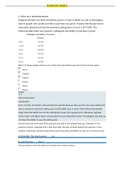
Econ 201 Quiz 4 Questions and Answers
- Examen
- • 27 páginas's •
-
California State University - San Marcos•ECON 304
Vista previa 3 fuera de 27 páginas
Econ 201 Quiz 4 Questions and Answers
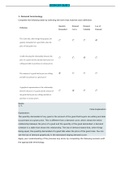
ECON 201 Quiz 3 Questions and Answers (Updated)
- Examen
- • 26 páginas's •
-
California State University - San Marcos•ECON 304
Vista previa 3 fuera de 26 páginas
ECON 201 Quiz 3 Questions and Answers (Updated)

1. What provides direction for individualized care and assures the delivery of accurate, safe care through a definitive pathway that promotes the client’s and the support persons’ progress toward positive outcomes? a. Physician’s orders b. Progress notes c. Nursing care plan d. Client health history ANS: C The nursing care plan provides direction for individualized care and assures the delivery of accurate, safe care through a definitive pathway that promotes the client’s a...
- Examen
- • 481 páginas's •
-
California State University - San Marcos•NURSING
Vista previa 4 fuera de 481 páginas
1. What provides direction for individualized care and assures the delivery of accurate, safe care through a definitive pathway that promotes the client’s and the support persons’ progress toward positive outcomes? a. Physician’s orders b. Progress notes c. Nursing care plan d. Client health history ANS: C The nursing care plan provides direction for individualized care and assures the delivery of accurate, safe care through a definitive pathway that promotes the client’s a...

1. What provides direction for individualized care and assures the delivery of accurate, safe care through a definitive pathway that promotes the client’s and the support persons’ progress toward positive outcomes? a. Physician’s orders b. Progress notes c. Nursing care plan d. Client health history ANS: C The nursing care plan provides direction for individualized care and assures the delivery of accurate, safe care through a definitive pathway that promotes the client’s a...
- Examen
- • 481 páginas's •
-
California State University - San Marcos•NURSING
Vista previa 4 fuera de 481 páginas
1. What provides direction for individualized care and assures the delivery of accurate, safe care through a definitive pathway that promotes the client’s and the support persons’ progress toward positive outcomes? a. Physician’s orders b. Progress notes c. Nursing care plan d. Client health history ANS: C The nursing care plan provides direction for individualized care and assures the delivery of accurate, safe care through a definitive pathway that promotes the client’s a...
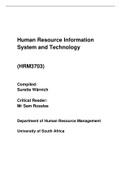
HUMAN RESOURCE INFORMATION SYSTEM AND TECHNOLOGY
- Notas de lectura
- • 234 páginas's •
-
California State University - San Marcos•HRM 3703
Vista previa 4 fuera de 234 páginas
HUMAN RESOURCE INFORMATION SYSTEM AND TECHNOLOGY
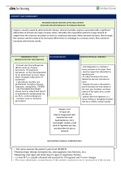
Case|Elaborated/Answered| NURS 310 - Nursing Assessment for the RN - Vsims Carl Shapiro Vanessa Forrest Angina is usually caused by atherosclerotic disease. Almost invariably, angina is associated with a significant obstruction of at least one major coronary artery. Normally, the myocardium extracts a large amount of oxygen from the coronary circulation to meet its continuous demands. When demand increases, flow through the coronary arteries needs to be increased. When there is a blockage in a c...
- Examen
- • 17 páginas's •
-
California State University - San Marcos•NURS 310 - Nursing Assessment For The RN
Vista previa 3 fuera de 17 páginas
Case|Elaborated/Answered| NURS 310 - Nursing Assessment for the RN - Vsims Carl Shapiro Vanessa Forrest Angina is usually caused by atherosclerotic disease. Almost invariably, angina is associated with a significant obstruction of at least one major coronary artery. Normally, the myocardium extracts a large amount of oxygen from the coronary circulation to meet its continuous demands. When demand increases, flow through the coronary arteries needs to be increased. When there is a blockage in a c...
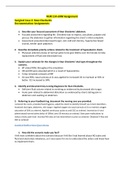
Case |Elaborated/Answered| NURS 310 - Nursing Assessment for the RN -vSIM-Stan Checketts. Surgical Case 2: Stan Checketts Documentation Assignments 1. Describe your focused assessment of Stan Checketts’ abdomen. • Focused assessment regarding Mr. Checketts was to inspect, auscultate, palpate and percuss the abdomen to gather information regarding the client’s initial complaint. • Assessment presented decreased turgor, skin cold and clammy, hyperactive bowel sounds, tender upon p...
- Examen
- • 3 páginas's •
-
California State University - San Marcos•NURS 310 - Nursing Assessment for the RN
Vista previa 1 fuera de 3 páginas
Case |Elaborated/Answered| NURS 310 - Nursing Assessment for the RN -vSIM-Stan Checketts. Surgical Case 2: Stan Checketts Documentation Assignments 1. Describe your focused assessment of Stan Checketts’ abdomen. • Focused assessment regarding Mr. Checketts was to inspect, auscultate, palpate and percuss the abdomen to gather information regarding the client’s initial complaint. • Assessment presented decreased turgor, skin cold and clammy, hyperactive bowel sounds, tender upon p...
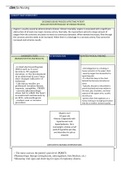
Case|Elaborated/Answered| NURS 310 - Nursing Assessment for the RN - Vsims Carl Shapiro Vanessa Forrest Angina is usually caused by atherosclerotic disease. Almost invariably, angina is associated with a significant obstruction of at least one major coronary artery. Normally, the myocardium extracts a large amount of oxygen from the coronary circulation to meet its continuous demands. When demand increases, flow through the coronary arteries needs to be increased. When there is a blockage in ...
- Package deal
- Examen
- • 18 páginas's •
-
California State University - San Marcos•NURS 310 - Nursing Assessment for the RN
-
NURS 310 - Nursing Assessment for the RN-Vsim Collection(All Responded)• PorProfExams
Vista previa 3 fuera de 18 páginas
Case|Elaborated/Answered| NURS 310 - Nursing Assessment for the RN - Vsims Carl Shapiro Vanessa Forrest Angina is usually caused by atherosclerotic disease. Almost invariably, angina is associated with a significant obstruction of at least one major coronary artery. Normally, the myocardium extracts a large amount of oxygen from the coronary circulation to meet its continuous demands. When demand increases, flow through the coronary arteries needs to be increased. When there is a blockage in ...
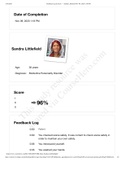
Case |Elaborated/Answered| NURS 310 - Nursing Assessment for the RN -VSIM Steps Sandra Littlefield 0:00 Patient 0:00 You checked scene safety. It was correct to check scene safety in order to maintain your own safety. 0:06 You introduced yourself. 0:33 You washed your hands. 0:42 You identified the patient. 0:56 You asked if the patient had any known allergies. 1:11 You asked the patient: Can you tell me a little bit more about what's going on with you today? It was appropriate to as...
- Examen
- • 6 páginas's •
-
California State University - San Marcos•NURS 310 - Nursing Assessment for the RN
Vista previa 2 fuera de 6 páginas
Case |Elaborated/Answered| NURS 310 - Nursing Assessment for the RN -VSIM Steps Sandra Littlefield 0:00 Patient 0:00 You checked scene safety. It was correct to check scene safety in order to maintain your own safety. 0:06 You introduced yourself. 0:33 You washed your hands. 0:42 You identified the patient. 0:56 You asked if the patient had any known allergies. 1:11 You asked the patient: Can you tell me a little bit more about what's going on with you today? It was appropriate to as...
